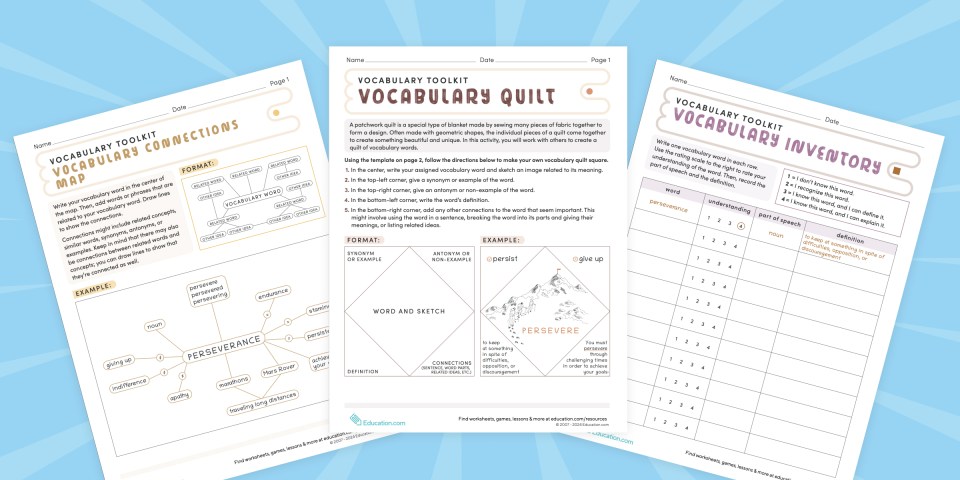
One of the most exciting aspects of teaching is guiding students through a new book. As we approach Reading Month in March, Education.com’s curated Visual Vocabulary Toolkit supports educators by offering creative ways for students to engage with and deeply understand the words they read.
As your class tackles their next vocabulary list, have them choose from our Toolkit of 10 worksheets that are as unique as they are! Each one is designed with a different learning style in mind and makes language learning dynamic and interactive, providing students with the tools they need to understand new vocabulary words:
Tools for tracking vocabulary as they read


1. Vocabulary inventory
This Vocabulary Inventory Print-out from our Toolkit of worksheets is an excellent starting point for students to catalog new words as they read.
An organized list allows them to write down definitions and parts of speech while also keeping track of their understanding. Using the rating scale in the second column, they can pinpoint the words they need to focus on and go beyond the surface for the words they already know, making sure they not only define each word, but explain it as well.
2. Visual vocabulary
For the visual learner, drawing can be a powerful tool in solidifying word meanings. Students with this learning style can use a Visual Vocabulary Worksheet to sketch pictures or symbols that represent words. They’ll fill the chart with images of up to 10 terms, using visual association to enhance understanding and retention.
Tools for deeply understanding each word


3. Vocabulary map
Make connections between words with a Vocabulary Map, part of our Toolkit of worksheets!
As your learners start to understand a word’s definition, challenge them to draw a mind map that explores its synonyms, antonyms, and related concepts. This creative tool will encourage them to think about the meaning of the term in the context of similar words and ideas.
4. Vocabulary quilt
Another way to form connections is through a Vocabulary Quilt! This worksheet has students design quilt squares for each word, incorporating its definition, an illustration, a synonym or example, and an antonym or non-example.
Then, they can connect their squares and display the quilt as a collaborative, visual representation of your classroom’s expanding vocabulary.


5. Vocabulary acrostic
Turn word learning into poetry with a Vocabulary Acrostic.
Students will write out a vocabulary word and use its letters to write an original acrostic poem, adding in words or phrases associated with the word. By incorporating related examples, they’ll form a deeper connection to the word’s meaning.
6. Word profile
Personify a word, and bring it to life!
This one-page Word Profile asks kids to pretend a vocabulary word is a person and create a profile for it. They’ll have to think creatively as they assign it an occupation, hometown, and various hobbies and interests. Encourage word sense, connotation, and wordplay with this worksheet.


7. Vocabulary analysis
Unravel the layers of meaning within a word with this Vocabulary Analysis Worksheet. Students will delve into a term’s definition, part of speech, connotation, category, associated color, and even wordplay, writing a joke or pun using the word!
8. Vocabulary note cards
Emphasize what matters with these Vocabulary Note Cards. Students will use these simple cards to note the most important information about the terms on their vocabulary list, including a definition, synonyms, an example sentence, and a personal connection. This portable study tool is perfect for review and reinforcement.


9. Graphic organizer for words with multiple meanings
Navigate the nuances of words with multiple meanings using a specialized Multi-Meaning Words Graphic Organizer. Your class will explore one word in two different contexts, filling in spaces on the left and right for its disparate meanings, parts of speech, example sentences, and illustrations.
10. Vocabulary deep dive
Immerse yourself in a term’s history, etymology, and connotation to understand it more deeply!
Using this Vocabulary Deep Dive from our Toolkit, have your students select a word from their list and conduct thorough research, exploring its historical context, cultural significance, and contemporary usage. This exercise promotes curiosity, critical thinking, and appreciation for language.
Reading Month Story Challenge: Unleash your inner author!
In the spirit of Reading Month, we present an exciting Reading Month Story Challenge for young writers:
Prompt: From March 1 to 31, craft a short story (up to 5,000 words) filled with daring escapades, mysterious journeys, or fantastical quests! The story can be fiction or nonfiction, really anything — as long as it is an original work. Parents and teachers can submit each child’s story to Education.com using our printable online form.
Deadline: Submit your epic tale to stories@education.com by March 31. For rules and details, please click here.
Prizes: Up to 10 winners will be chosen from the following grade levels: PreK-1st, 2-3rd, 4-5th, and 6-8th. Winners will receive one year of Education.com Premium membership, and all participants will receive a coveted Certificate of Participation!
Let your students’ imaginations soar as they embark on a literary journey this Reading Month!
With this Visual Vocabulary Toolkit at your disposal and the Reading Month Story Challenge beckoning, Education.com offers many ways for young learners to explore books and language—whether they’re reading a story or writing their own!
The post Toolkit of 10 vocabulary worksheets for Reading Month appeared first on Education.com Blog.